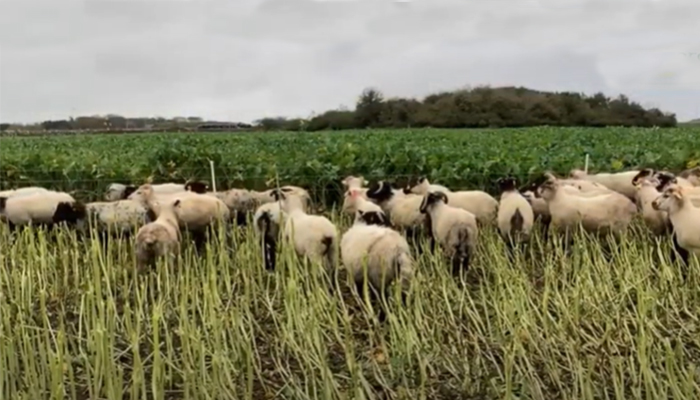15 January 2021
Achieving Maximum Utilisation of Forage Crops with Sheep

The key to improve utilisation of a forage crop is to choose the correct crop for your farm and farming system. Different crop species have different sowing times, utilisation periods and dry matter yield. Eamonn Dempsey, Teagasc Advisor has the details
Finishing lambs on Typhon or Rape
For finishing lambs post weaning, rapid growing crops such as Tyfon or Rape are most suitable as these can be sown in April so that the first grazing will coincide with weaning time in June/July. Tyfon and Rape also have the advantage that where they are leniently grazed they will re-grow for further grazing every five to eight weeks. Research shows that one acre of Tyfon should finish 25 to 35 lambs, with weight gains of 300 grams per day at a time of year when thrive off grass is reduced.
Swedes and fodder beet
Other forage crops such as swedes and fodder beet only provide a single grazing but high yields per hectare will increase carrying capacity. Swedes can be lifted and stored in a clamp, however most are grazed in situ. In general brassicas destined for out-wintering stock should be completely grazed by early March as they tend to flower after the winter which may lead to health issues for stock. Forage crops are well suited to sheep grazing, with a run back area to allow for a greater number of lambs to be finished off any given crop.
Crop utilisation tips
Crop utilisation will depend on:
- crop type
- yield
- grazing management
- weather conditions and
- soil type
To maximise utilisation of the forage crop you must know the expected dry matter yield, calculate the total daily dry matter intake for the number of sheep you wish to carry and factor in the expected utilisation of the crop at around 70 percent. This will give you the number of days grazing you can expect.
Care must be taken not to force animals too hard to consume unpalatable parts of the crop i.e. roots, stem and soiled leaves. Sheep should be introduced gradually to forage crops, so ensure that fencing is very secure as poisoning can occur if animals break through and gorge themselves. Sheep need around 30% fibre in diet so feed fibrous roughage such as hay or silage with water. Forage crops are generally low in trace elements such as selenium, iodine, copper and cobalt so access to high quality minerals or boluses are necessary to avoid any potential problems. When deciding on how to graze the crop, long and narrow is better than short and wide, so animals get fresh feed and trampling is kept to a minimum. Move the sheep fence to the face of the crop every 2-3 days in good weather and ground conditions and daily in poor conditions. Do not feed frozen crops, wait for them to thaw out and avoid grazing older ewes on roots as it may damage their teeth. Check your flock for lameness and remove lame sheep for treatment before introducing to the forage crop.
Clean livestock policy
If finishing lambs on forage crops, they may need to be removed for the last few weeks before marketing to adhere the requirements of the clean livestock policy. Forage crops are palatable, high in energy and available for feeding mainly from October to March replacing grass which is either closed off or in short supply.
More advice on Fodder crops can be found on the Teagasc website here
